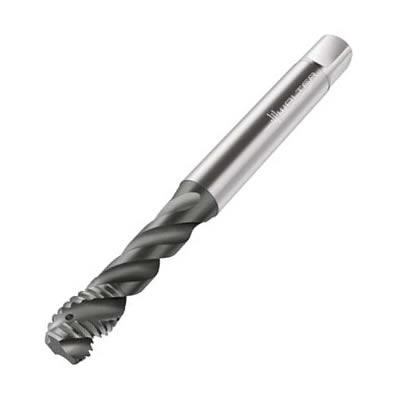
Walter USA LLC has unveiled the latest version of the Walter Prototyp Paradur Eco Plus blind-hole tap, a versatile performer that also offers long tool life plus enhanced reliability.
Key to its extremely wide application range is its construction. The tool is manufactured out of HSS-E PM and is optionally available with THL or TiN coating, and external or internal cooling with radial or axial coolant outlet. This allows the tap to successfully process a broad range of materials including structural and high tensile steels, abrasive materials and materials which tend to fuse, stainless steels, malleable cast iron, plus copper/aluminum alloys. And thanks to its helix angle of 45 degrees, long flutes and a tapered guide, the Prototyp Paradur Eco Plus cuts threads in blind-holes up to a depth of 3 diameters deep.
The latest version of the Prototyp Paradur Eco Plus benefits from enhancements both to its micro-geometry and to its manufacture, which employs the most advanced methods throughout the entire tool production process, from the initial machining of blanks all the way through finish grinding. These enhancements provide up to 30 percent higher tool life in comparison with the previous tool. For example, in a field test in which M6 blind hole threads were cut in locking rings made of 316L (V4A) stainless steel, the Prototyp Paradur Eco Plus made 1110 threads, while its competitor with a similar design achieved 720 threads.
Walter now offers the Prototyp Paradur Eco Plus in a broad range of sizes up to M64. Additionally, variants for metric and inch fine threads are available. In some cases there are also left hand thread variants in standard sizes.
Contact Details
Related Glossary Terms
- abrasive
abrasive
Substance used for grinding, honing, lapping, superfinishing and polishing. Examples include garnet, emery, corundum, silicon carbide, cubic boron nitride and diamond in various grit sizes.
- alloys
alloys
Substances having metallic properties and being composed of two or more chemical elements of which at least one is a metal.
- blind-hole
blind-hole
Hole or cavity cut in a solid shape that does not connect with other holes or exit through the workpiece.
- coolant
coolant
Fluid that reduces temperature buildup at the tool/workpiece interface during machining. Normally takes the form of a liquid such as soluble or chemical mixtures (semisynthetic, synthetic) but can be pressurized air or other gas. Because of water’s ability to absorb great quantities of heat, it is widely used as a coolant and vehicle for various cutting compounds, with the water-to-compound ratio varying with the machining task. See cutting fluid; semisynthetic cutting fluid; soluble-oil cutting fluid; synthetic cutting fluid.
- flutes
flutes
Grooves and spaces in the body of a tool that permit chip removal from, and cutting-fluid application to, the point of cut.
- grinding
grinding
Machining operation in which material is removed from the workpiece by a powered abrasive wheel, stone, belt, paste, sheet, compound, slurry, etc. Takes various forms: surface grinding (creates flat and/or squared surfaces); cylindrical grinding (for external cylindrical and tapered shapes, fillets, undercuts, etc.); centerless grinding; chamfering; thread and form grinding; tool and cutter grinding; offhand grinding; lapping and polishing (grinding with extremely fine grits to create ultrasmooth surfaces); honing; and disc grinding.
- helix angle
helix angle
Angle that the tool’s leading edge makes with the plane of its centerline.
- malleable cast iron
malleable cast iron
Cast iron made by prolonged annealing of white cast iron in which decarburization and/or graphitization take place to eliminate some or all of the cementite. The graphite is in the form of temper carbon. There are ferritic and perlitic malleable cast irons. Their typical composition ranges are: 2.2 to 2.9 percent carbon, 0.2 to 1.3 percent manganese, 0.9 to 1.9 percent silicon, 0.05 to 0.18 percent sulfur and 0.18 percent (maximum) phosphorus.
- stainless steels
stainless steels
Stainless steels possess high strength, heat resistance, excellent workability and erosion resistance. Four general classes have been developed to cover a range of mechanical and physical properties for particular applications. The four classes are: the austenitic types of the chromium-nickel-manganese 200 series and the chromium-nickel 300 series; the martensitic types of the chromium, hardenable 400 series; the chromium, nonhardenable 400-series ferritic types; and the precipitation-hardening type of chromium-nickel alloys with additional elements that are hardenable by solution treating and aging.
- tap
tap
Cylindrical tool that cuts internal threads and has flutes to remove chips and carry tapping fluid to the point of cut. Normally used on a drill press or tapping machine but also may be operated manually. See tapping.
- titanium nitride ( TiN)
titanium nitride ( TiN)
Added to titanium-carbide tooling to permit machining of hard metals at high speeds. Also used as a tool coating. See coated tools.

